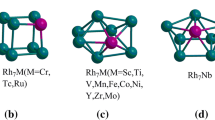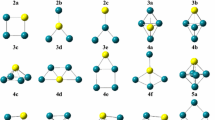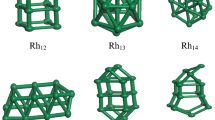Abstract
The stability and electronic and magnetic properties of RhnOs (n= 2–12) clusters in their most stable configurations were systematically studied by using density functional theory (DFT) at M06L/aug-cc-pVDZ level. Calculation of the second-order difference of energies and fragmentation energies exhibited that Rh3Os, Rh5Os, Rh7Os, and Rh9Os clusters are more stable than any other clusters. The calculated HOMO-LUMO energy gaps of the RhnOs clusters are found to be in the range of 0.018 to 0.299 eV, implying that the metallic behavior can appear in these clusters. Accordingly, the RhnOs clusters can be employed as heterogeneous nanocatalysts in many chemical reactions. The local Fukui function (\(f_{k}^{-} )\) has also been calculated, and the obtained results reveal that the highest \(f_{k}^{-} \) values are predicted for the Rh atoms. Therefore, the Rh atoms in the clusters are considered the most reactive sites that undergo reactions with electrophilic reagents. The analysis of the magnetic properties of the RhnOs clusters shows that the total magnetic moment per atom of these clusters varies from 0.67 to 1.75 µB/atom. And, the PDOS analysis reveals that the d orbitals play a crucial role for the magnetism of the RhnOs clusters, and the contribution of the s and p orbitals is small.







Similar content being viewed by others
References
Schmid, G.: Large clusters and colloids. Metals in the embryonic state. Chem. Rev. 92, 1709–1727 (1992)
Lewis, L.N.: Chemical catalysis by colloids and clusters. Chem. Rev. 93, 2693–2730 (1993)
Xu, X.S., Yin, S.Y., Moro, R., de Heer, W.A.: Magnetic moments and adiabatic magnetization of free cobalt clusters. Phys. Rev. Lett. 95, 237209 (2005)
Parks, E.K., Klots, T.D., Riley, S.J.: Chemical probes of metal cluster ionization potentials. J. Chem. Phys. 92, 3813–3826 (1990)
Cox, A.J., Louderback, J.G., Apsel, S.E., Bloomfield, L.A.: Magnetism in 4d-transition metal clusters. Phys. Rev. B 49, 12295–12298 (1994)
Soltani, A., Boudjahem, A.: Stabilities, electronic and magnetic properties of small Rhn (n = 2-12) clusters: a DFT approach. Comput. Theor. Chem. 1047, 6–14 (2014)
Yonezawa, T., Imamura, K., Kimizuka, N.: Direct preparation and size control of palladium nanoparticle hydrosols by water-soluble isocyanide ligands. Langmuir 17, 4701–4703 (2001)
Zhang, J.Y., Fang, Q., Kenyon, A.J., Boyd, I.W.: Visible photoluminescence from nanocrystalline Ge grwn at room temperature by photo-oxidation of SiGe using a 126 nm lamp. Appl. Surf. Sci. 208–209, 364–368 (2003)
Dong, C.D., Gong, X.G.: Magnetism enhanced layer-like structure of small cobalt clusters. Phys. Rev. B 78, 020409–020412 (2008)
Teranishi, T., Miyake, M.: Size control of palladium nanoparticles and their crystal structures. Chem. Mater. 10, 594–600 (1998)
Gopidas, K.R., Whitesell, J.M., Fox, M.A.: Synthesis, characterization, and catalytic applications of a palladium-nanoparticles-cored dendrimer. Nano. Lett. 3, 1757–1760 (2003)
Boudjahem, A., Chettibi, M., Monteverdi, S., Bettahar, M.: Acetylene hydrogenation over NiCu nanoparticles supported on silica prepared by aqueous hydrazine reduction. J. Nanosci. Nanotechnol. 9, 3546–3554 (2009)
Boudjahem, A., Redjel, A., Mokrane, T.: Preparation, characterization and performance of Pd/SiO2 catalyst for benzene catalytic hydrogenation. J. Ind. Eng. Chem. 18, 303–308 (2012)
Chettibi, M., Boudjahem, A., Bettahar, M.: Synthesis of Ni/SiO2 nanoparticles for catalytic benzene hydrogenation. Transit. Metal. Chem. 36, 163–169 (2011)
Boudjahem, A., Bouderbala, W., Bettahar, M.: Benzene hydrogenation over Ni-Cu/SiO2 catalysts prepared by aqueous hydrazine reduction. Fuel. Process. Technol. 92, 500–506 (2011)
Sidhpuria, K.B., Patel, H.A., Parikh, P.A., Bahadur, P., Bajaj, H.C., Jasra, R.V.: Rhodium nanoparticles intercalated into montmorillonite for hydrogenation of aromatic compounds in the presence of thiophene. Appl. Clay. Sci. 42, 386–390 (2009)
Sanchez, A., Fang, M., Ahmed, A., Sanchez-Delgado, R.A.: Hydrogenation of arenes, N-heteroaromatic compounds, and alkenes catalyzed by rhodium nanoparticles supported on magnesium oxide. Appl. Catal. A 477, 117–124 (2014)
Campos, C.H., Rosenberg, E., Fierro, J.L., Urbano, B.F., Rivas, B.L., Torres, C.C., Reyes, P.A.: Hydrogenation of nitro-compounds over rhodium catalysts supported on poly(acrylic acid)/Al2O3 composites. Appl. Catal. A 489, 280–291 (2015)
Behr, A., Brunsch, Y., Lux, A.: Rhodium nanoparticles as catalysts in the hydroformylation of 1-dodecene and their recycling in thermomorphic solvent systems. Tetrahedron. Lett. 53, 2680–2683 (2012)
Bruss, A.J., Gelesky, M.A., Machado, G., Dupont, J.: Rh(0) nanoparticles as catalyst precursors for the solventless hydroformylation of olefins. J. Mol. Catal. A 252, 212–218 (2006)
Yoon, T.J., Kim, J.I., Lee, J.K.: Rh-based olefin hydroformylation catalysts and the change of their catalytic activity depending on the size of immobilizing supporters. Inorg. Chim. Acta. 345, 228–234 (2003)
Han, D., Li, X., Zhang, H., Liu, Z., Hu, G., Li, C.: Asymmetric hydroformylation of olefins catalyzed by rhodium nanoparticles chirally stabilized with (R)-BINAP ligan. J. Mol. Catal. A 283, 15–22 (2008)
Cox, A.J., Louderback, J.G., Bloomfield, L.A.: Experimental observation of magnetism in rhodium clusters. Phys. Rev. Lett. 71, 923–926 (1993)
Bertoli, M., Choualeb, A., Lough, A.J., Moore, B., Spasyuk, D., Gusev, D.G.: Osmium and ruthenium catalysts for dehydrogenation of alcohols. Organometallics 30, 3479–3482 (2011)
Mendes, F.M., Schmal, M.: The cyclohexanol dehydrogenation on Rh-Cu/Al2O3 catalysts: chemisorpion and reaction. Appl. Catal. A: Gen. 163, 153–164 (1997)
Trunschke, A., Ewald, H., Gutschick, D., Miessner, H., Skupin, M., Walther, B., Bottcher, H.C.: New bimetallic Rh-Mo and Rh-W clusters as precursors for selective heterogeneous CO hydrogenation. J. Mol. Catal. 56, 95–106 (1989)
Zitoun, D., Amiens, C., Chaudret, B.: Synthesis and magnetism of CoxRh1−x and CoxRu1−x nanoparticles. J. Phys. Chem. B 107, 6997–7005 (2003)
Rakap, M.: The highest catalytic activity in the hydrolysis of ammonia borane by poly(N-vinyl-2-pyrrolidone)-protected palladium-rhodium nanoparticles for hydrogen generation. Appl. Catal. B 163, 129–134 (2015)
Jiang, H.-L., Xu, Q.: Catalytic hydrolysis of ammonia borane for chemical hydrogen storage. Catal. Today 170, 56–63 (2011)
Shen, J., Cao, N., Liu, Y., He, M., Hu, K., Luo, W., Cheng, G.: Hydrolytic dehydrogenation of amine-boranes catalyzed graphene supported rhodium-nickel nanoparticles. Catal. Commun. 59, 14–20 (2015)
Durap, F., Zahmakiran, M., Ozkar, S.: Water soluble laurate-stabilized rhodium (0) nanoclusters catalyst with unprecedented catalytic lifetime in the hydrolytic dehydrogenation of ammonia borane. Appl. Catal. A 369, 53–59 (2009)
Srivastava, A.K., Misra, N.: Structures, stabilities, electronic and magnetic properties of small RhxMny (x + y = 2-4) clusters. Comput. Theor. Chem. 1047, 1–5 (2014)
Mokkath, J.H., Pastor, G.M.: First-principles study of structural, magnetic, and electronic properties of small Fe-Rh alloy clusters. Phys. Rev. B 85, 054407 (2012)
Dennler, S., Morillo, J., Pastor, G.M.: Calculation of magnetic and structural properties of small Co-Rh clusters. Surf. Sci. 532–535, 334–340 (2003)
Lv, J., Bai, X., Jia, J.F., Xu, X.H., Wu, H.S.: Structural, electronic and magnetic properties of ConRh clusters from density functional calculations. Physica B. 407, 14–21 (2012)
Yang, J.X., Wei, C.F., Guo, J.J.: Density functional study of AunRh (n = 1-8) clusters. Physica B. 405, 4892–4896 (2010)
Frisch, M.J., Trucks, G.W., Schlegel, H.B., Scuseria, G.E., Robb, M.A., Cheeseman, J.R., Scalmani, G., Barone, V., Mennucci, B., Petersson, G.A., Nakatsuji, H., Caricato, M., Li, X., Hratchian, H.P., Izmaylov, A.F., Bloino, J., Zheng, G., Sonnenberg, J.L., Hada, M., Ehara, M., Toyota, K., Fukuda, R., Hasegawa, J., Ishida, M., Nakajima, T., Honda, Y., Kitao, O., Nakai, H., Vreven, T., Montgomery, J.A. Jr., Peralta, J.E., Ogliaro, F., Bearpark, M., Heyd, J.J., Brothers, E., Kudin, K.N., Staroverov, V.N., Keith, T., Kobayashi, R., Normand, J., Raghavachari, K., Rendell, A., Burant, J.C., Iyengar, S.S., Tomasi, J., Cossi, M., Rega, N., Millam, J.M., Klene, M., Knox, J.E., Cross, J.B., Bakken, V., Adamo, C., Jaramillo, J., Gomperts, R., Stratmann, R.E., Yazyev, O., Austin, A.J., Cammi, R., Pomelli, C., Ochterski, J.W., Martin, R.L., Morokuma, K., Zakrzewski, V.G., Voth, G.A., Salvador, P., Dannenberg, J.J., Dapprich, S., Daniels, A.D., Farkas, O., Foresman, J.B., Ortiz, J.V., Cioslowski, J., Fox, D.J.: Gaussian 09, revision D.01. Gaussian, Inc., Wallingford (2013)
Zhao, Y., Truhlar, D.G.: A new local density functional for main-group thermochemistry, transition metal bonding, thermochemical kinetics, and noncovalent interactions. J. Chem. Phys. 125, 194101 (2006)
Zhao, Y., Truhlar, D.G.: Density functionals with broad applicability in chemistry. Acc. Chem. Res. 41, 157–167 (2008)
Dunning, T.H.: Gaussian basis sets for use in correlated molecular calculations. I. The atoms boron through neon and hydrogen. J. Chem. Phys. 90, 1007–1023 (1989)
Khetrapal, N.S., Jian, T., Lopez, G.V., Pande, S., Wang, L.-S., Zeng, X.C.: Probing the structural evolution of gold-aluminum bimetallic clusters (Au2Aln−, n = 3-11) using photoelectron spectroscopy and theoretical calculations. J. Phys. Chem. C 121, 18234–18243 (2017)
Khetrapal, N.S., Jian, T., Pal, R., Lopez, G.V., Pande, S., Wang, L.-S., Zeng, X.C.: Probing the structures of gold-aluminum alloy clusters AuxAly−: a joint experimental and theoretical study. Nanoscale 8, 9805–9814 (2016)
Khetrapal, N.S., Satya, S.S., Zeng, X.C.: Structural evolution of gold clusters Aun− (n = 21-25), revised. J. Phys. Chem. A 121, 2466–2474 (2017)
Beltran, M.R., Zamudio, F.B., Chauhan, V., Sen, P., Wang, H., Ko, Y.J., Bowen, K.: Ab initio and anion photoelectron studies of Rhn (n = 1-9) clusters. Eur. Phys. J. D 67, 63–70 (2013)
Chien, C.H., Blaisten-Barojas, E., Pederson, M.R.: Magnetic and electronic properties of rhodium clusters. Phys. Rev A 58, 2196–2202 (1998)
Gingerich, K.A., Cocke, D.L.: Thermodynamic confirmation for the high stability of gaseous TiRh as predicted by the Brewer-Engel metallic theory and the dissociation energy of diatomic rhodium. J. Chem. Soc. Chem. Commun. 1, 536–536 (1972)
Jules, J.L., Lombardi, J.R.: Transition metal dimer internuclear distances from measured force constants. J. Phys. Chem A 107, 1268–1273 (2003)
Morse, M.D.: Clusters of transition-metal atoms. Chem. Rev. 86, 1049–1109 (1986)
Du, J., Sun, X., Wang, H.: The confirmation of accurate combination of functional and basis set for transition-metal dimers: Fe2, Co2, Ni2, Ru2, Rh2, Pd2, Os2, Ir2, and Pt2. Int. J. Quantum. Chem. 108, 1517–1517 (2008)
Wu, Z.J., Han, B., Dai, Z.W., Jin, P.C.: Electronic properties of rhenium, osmium and iridium dimmers by density functional methods. Chem. Phys. Lett. 403, 367–371 (2005)
Cimpeanu, V., Kocevar, M., Parvulescu, V., Leitner, W.: Preparation of rhodium nanoparticles in carbon dioxide induced ionic liquids and their application to selective hydrogenation. Angew. Chem. Int. 48, 1085–1088 (2009)
Author information
Authors and Affiliations
Corresponding author
Ethics declarations
Conflict of interests
The authors declare that they have no conflict of interest.
Rights and permissions
About this article
Cite this article
Boudjahem, AG., Boulbazine, M. & Chettibi, M. Electronic and Magnetic Properties of Os-Doped Rhodium Clusters: a Theoretical Study. J Supercond Nov Magn 31, 3119–3131 (2018). https://doi.org/10.1007/s10948-018-4579-x
Received:
Accepted:
Published:
Issue Date:
DOI: https://doi.org/10.1007/s10948-018-4579-x




